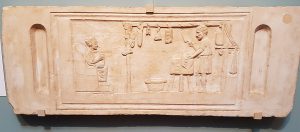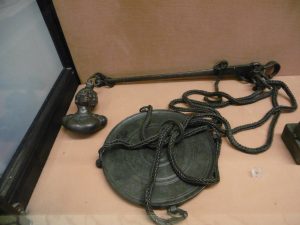This month’s post is by PhD student Philip Smither.
How many apples do you get in a lb? Four small or three medium or two large is the usual answer. It might seem an insignificant measure in the grand scheme of things, however, the use of measurement to control the trade and production of everyday items was important to the success of the Roman Empire.
Walking north through the forum of Pompeii, built into the side of the Temple of Apollo is a small room with a concrete table in which are carved five holes; the Mensa Ponderaria (Public weights and measures table). These holes relate to the Oscan measurements used in Pompeii during the 2nd – 1st centuries BC. This public table allowed residents and visitors to Pompeii to check that they were not being cheated by unscrupulous market stall or shop owners.
Image 1: Mensa Ponderarria in Pompeii
By the time of Augustus, a new system of weights and measures was rolled out Empire wide to create a new standard. That meant that from Britain to Syria, North Africa to Germany, everyone would work to and sell using the same standard. To facilitate this, in Pompeii the Mesa Ponderaria underwent a transformation. The holes for Oscan measurements were resized and four new holes were added at each corner. This is attested in an inscription that reads:
A(ulus) Clodius A(uli) f(ilius) Flaccus N(umerius) Arcaeus N(umeri) f(ilius) Arellian(us) Caledus d(uum)v(iri) i(ure) d(icundo) mensuras exaequandas ex dec(urionum) decr(eto) (CIL X.793@)
Aulus Clodius Flaccus, son of Aulus, and Numerius Arcaeus Arellianus Caledus, son of Numerius, duumvirs with judicial power, saw to the standardization of the measures in accordance with a decree of the town councillors.
It was the job of these town magistrates to see to and enforce the changes. Similarly, close by in Herculaneum, it was the job of the duumvirs to control the weights (CIL X.1453). At their own expense, the duumvirs, Marci Remmii Rufi and his son, constructed the town weights and were diligent in taking steps against faults in weights. Due to their generosity, they were given management of their weights.

Image 2: Weights cabinet in the Museum of Naples
However, this attempt at standard measurements was not wholly successful. Several sources of archaeological evidence point to inaccurate Roman measures. Many studies have concluded various estimates for Roman measurements. The weight of the Roman libra has been estimated to be anywhere between 322 – 329g (11.4 – 11.6oz) from coins, everyday objects and actual weights. One interesting collection of objects is the silver spoons from the Thetford Hoard found in Norfolk. A total of 33 spoons from the hoard showed that many were made to a very similar weight. This provided a Roman libra of 324 – 328g; in the middle of the other estimates. Due to damage and wear, the actual libra being used was probably closer to 328 – 329g.
To compound this problem even further, there is also evidence of deliberately falsified weights. While many merchants would like to have depicted themselves as honest in their business, acts of fraud are attested. A 1st – 2nd century BC inscription reveals a trader asking for forgiveness for selling quid minus mensura (smaller measures) (ILS 7479) (Rizzi, 2013: 291-92). Fraudulent measuring instruments may have also been constructed such as a cup from Porolissum (Găzdac and Wright, 2009: 185), however it is difficult to tell if weights are fraudulent or underweight due to wear. Justinian (Digest, 19.2.13.8) states that a merchant knowingly using false weights they would have them destroyed and be punished by the town magistrates. This process was enacted by the Aediles, Gnaeus Caninius Amiro and P. Aelius Felix, on the discovery of inadequate weights (CIL XIV 2625). Fines appear to have been imposed upon offenders with the proceeds used to construct official measures in the town (ILS 5613, 5614 and 5991). Merchants were not always the most popular figures in the Roman world, as Cicero (de Officina, 1.150) considered traders to be vulgar. Of these, fishmongers/fishermen, butchers, (both represented with steelyards), cooks and poulterers were the least reputable.

Image 3: Funerary relief of a Roman butcher with his weighing scales behind him
The use of weights in the Roman world goes far beyond their use only by merchants. The uses of weights and scales are numerous as any commodity can theoretically be weighed. Even the contents of amphorae were sold by weight (Cato the Elder, de Agricultura, 148, Lex Silia de ponderibus publicis (Plebicite on weights and measures, 287-218BC) (Paterson, 1982: 157)). However, this was likely done with wholesale goods in the ports of Roman provinces on large scales (Corti, 2001: 144-446). The majority of the evidence for use comes from funerary reliefs. One such depiction on a sign for a metal workshop shows workers beating and crafting metal, while a possible buyer stands to the left checking the scale (Corti, 2001: 152, fig.86). A scale also appears on the funerary monument of Marco Virgilio Eurisace (Eurysaces the baker) in Rome (Corti, 2001: 162, fig.94). The scale takes up the largest space on the frieze and is used to assert Eurysaces honesty as the weighing of loaves is overseen by officials (Hackworth Petersen, 2003: 244).

Image 4: A complete 1st century BC – 1st century AD weighing scale in the Museum of Naples
Others are depicted on multiple reliefs of merchants such as butchers, fishermen, and market traders. Two butchers are depicted on their funerary reliefs preparing meat with steelyards hanging in the background. On one, the balance is in this position of equilibrium, possibly demonstrating honesty the scale (Corti, 2001: 147, fig.79). The balance in this relief also used a figured weight, indicated by the double globular form. Another 2nd – 3rd century AD relief, this time from Neumagen, shows a fisherman weighing his catch or possibly a wool merchant (Franken, 1994: 218, D8) demonstrating the range in size of steelyards.
A 3rd century AD funerary relief depicts a merchant by the name of D. Caius Ficarius sitting by his wheelbarrow (used as makeshift stall at an amphitheater) and holding a scale in his hand (fig.19) (Corti, 2001: 150, fig.83). Another likely place for their use would be marketplaces. Markets and fairs of high or low-frequency, were held on a daily, weekly, monthly or annual basis in urban and rural locals (De Ligt, 1993). At large markets, officials could oversee the commercial activity. (De Ligt, 1993: 42-45). However, it is unclear whether they oversaw organizing the festival, or made any attempt to control the weights.
The Vindolanda tablets name a range of items that were weighed, including pork, lard, sinew, and iron. (Vindol. Tab. II No. 180, 182, 183, 186, 189, 192, 343), suggesting the weighing of rations as well as producing metal objects. One profession to use scales were doctors, or apothecaries, evidenced by finds of an equal scale and a steelyard from a doctor’s grave in Reims (Künzl, Hassel and Künzl, 1982: 61).
Some Roman scales used weights that depicted gods and goddesses. In Britain, Bacchus, the God of wine, and his entourage are common as well as the Mother Goddesses, associated with agriculture, of Isis and Cybele. It is possible that the owners of these weights traded wine and various crops. However, they also served another purpose. The idea that the gods were present would put faith in the customer that the merchant’s weights were honest. After all, who would want the wrath of the gods set upon them? Some weights had other associations. Weights shaped like acorns are particularly associated with the military. These weights represent the strength of the Roman military as well as the strength of the acorn to scale the scales, and one day grow into a strong oak tree. So, as well as being practical instruments for weighing, they also displayed different levels of meaning to the user and customer.

Image 5: Roman weight in the form of an acorn in the Museum of Naples
So, to return to the first question, how many apples do you get in a lb? In the Roman world, it depends on how honest the grocer is and how well the officials are checking the weights. We can be much more accurate with our weights today with superior instruments, but the basic scales we use in shops and kitchens are like Roman scales and prone to similar levels of inaccuracy.
CORTI, C. 2001. Pesi e misure nei commerci, arti, mestieri e professioni. in C. Corti and N. Giordani. Pondera. Pesi e Misure nell’antichita. pp. 143-166.
De LIGT, L. 1993. Fairs and markets in the Roman Empire. Economic and social aspects of periodic trade in a pre-industrial society. Amsterdam: J.C. Gieben.
FRANKEN, N. 1994. Aequiponia: figürliche Laufgewichte römischer und frühbyzantinischer Schnellwaagen. Alfter: VDG.
GĂZDAC, C. and WRIGHT, B. 2009. Counterfeiting official Roman weights. The inscribed cup-weight from Porolissum, EN 19, 183-190.
HACKWORTH PETERSEN, L. 2003. The Baker, his Tomb, his Wife and her Breadbasket. The Monument of Eurysaces in Rome. The Art Bulletin Vol. 85. 230-257.
KÜNZL, E. HASSEL, F.J. and S. KÜNZL. Medizinische Instrumente aus Sepulkralfunden der römischen Kaiserzeit. Bonner Jahrbücher 182. 1-131.
PATERSON, J. 1982. ‘Salvation from the Sea’: Amphorae and Trade in the Roman West. Journal for Roman Studies Vol. 71. 146-157.
RIZZI, M. 2013. Ex iniquitatibus mensurarum et ponderum: Appunti intorno alle frodi metrologiche nell’antichità greca e romana. The International Review of Roman Law 11, RIDROM. ONLINE. 288-331. Available from: [Accessed: 23 April, 2014].
